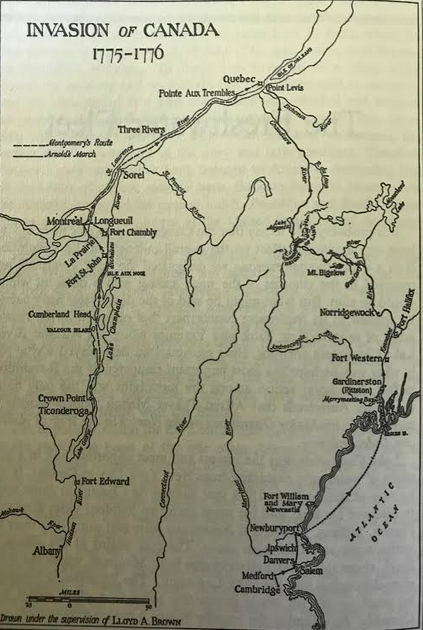
CAMDEN – Hodding Carter IV doesn’t quite match the sweater-vest-wearing, finger-pointing lecturers you might imagine when you hear the title ‘historian.’
Though he might don a sweater vest from time to time, the chances are slim to none that you’ll find Carter pointing any fingers while delivering a stuffy, monotone lecture on Eric the Red’s settlement of Greenland, or Lewis and Clark’s journey westward.
Carter tends to choose a more hands on approach.
For example: reliving the 350-mile river route taken by Benedict Arnold and his team of soldiers by paddling it himself, complete in traditional Colonial garb with traditional Colonial expedition meals.
The 1775 attempt to attack Quebec City began with more than 1,000 soldiers and 200 flat-bottomed river boats called bateaux. After sailing up the Maine coast from Cambridge, Mass. the army moved inward from Pittston, traveling up the Kennebec River before branching off along The Dead River and through Flagstaff Lake.
With early snow, inaccurate maps and numerous portages- including a 12-mile long haul- the army took a beating. Many soldiers weren’t accustomed to white water rapids and the boats began leaking from the rough journey, ruining food and gunpowder. More than 400 soldiers abandoned the trip, many became sick or injured and some died. By the time the crusade arrived in Quebec, less than 700 weak, starving men remained.
“Most people read about this journey and their reaction is ‘oh my god, that’s the most gruesome, horrible thing, thank god I never have to do that.’ But when I read about it my reaction was ‘oh my god, that’s the most gruesome, horrible thing, thank god I can try it myself’,” Carter said.
Carter, along with three friends, depart Sept. 25 from Pittston- retracing the strokes and steps of the famously disastrous expedition.
“A lot of people think of it as a failed trip, but I don’t see it that way. It was 700 men traveling through wilderness that had barely been touched except by natives. They succeeded in making that path. I see it as a huge accomplishment and this incredible moment in history,” Carter said.
This isn’t the first time Carter has felt compelled to reenact incredible moments in history. The award-winning, Mississippi-born writer has also retraced the paths of Lewis and Clark and sailed in a Viking ship across the Atlantic to “discover the new world.”

Never at a loss for finding humor in the struggle, Carter has found himself in some of the most outrageous and trying situations. The “Friends of Benedict Arnold Expedition 2017” is sure to contribute to his gallery of unimaginable scenarios.
“My friends are always asking to come on one of my trips with me, but when I told them about this one suddenly everyone had to wash their cars that weekend. The three coming with me seem to be similarly minded as me. It’s all about pitting myself and my friends against accomplishments like that of Benedict Arnold’s to see what it really took,” Carter said.
The crew, unlike Arnold’s soldiers, are well accustomed to the white water rivers of Northern Maine. One of the men, Rob Stevens, will be building the 400-pound bateaux within the next couple weeks- following the rushed construction of the historical account. The same boat builder helped construct the viking vessel used for Carter’s 1,500 mile journey from Greenland to Newfoundland.
The other two soldiers are boat savvy as well- one a guide on the very rivers the journey will see and the other a wilderness instructor at the University of Vermont.
Carter said his training has included walking with 80 pound weights on his shoulders- preparing for the roughly 40 miles total of portaging of a 400 pound boat. Not to mention supplies. The crew will be eating foods that were typical during that time period- salted pork, rice, beans, pan bread and porridge.
“Anyone who wants to come help us along will be fed salt pork and pan bread,” Carter said.
The route will wind through Franklin County near Eustis, and Carter is encouraging the public to get involved. He plans to update his website as often as possible, as well as the trip’s Facebook page. He also has plans to write about the journey along the way, with a book in mind after returning. But unlike his other expeditions, this one is purely for his own entertainment.
“It’s all about wanting to do this. I’m really excited to finally be going,” he said.
The seasoned adventurer is only worried about two things:
“My toes freezing off and whining too loudly. In your head is okay, but I’ve gotta keep the out loud stuff in check,” he said.
To follow Carter’s journey click here or check out the Facebook page here.





My son, Zebulon York Dingley, made this trip by canoe from Fort Western in Augusta to Quebec City at the age of fifteen, 17 years ago. Zeb was inspired by Kenneth Roberts’ book, “Arundel”. He had considerable advice from Duluth Wing who made made the trip himself years before that. I had the good fortune to join him from Arnold Pond to Quebec. The absolute trip of a lifetime. And the most afraid I’ve ever been in a canoe.